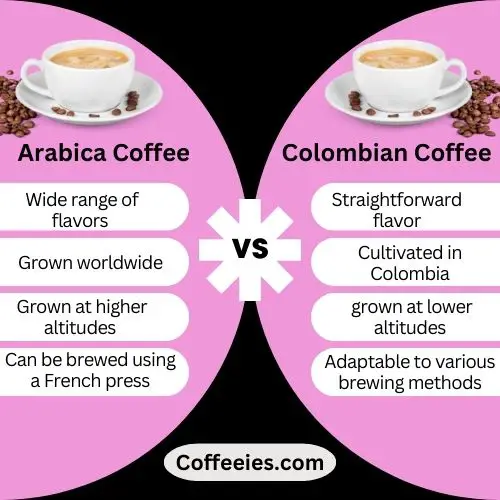Are you tired of settling for mediocre coffee? Well, brace yourself for a showdown between two giants in the world of coffee – Arabica vs. Colombian Coffee.
These beans pack a punch with their distinct flavor profiles, grown in different regions, cultivated with care, and roasted to perfection.
Get ready to dive into the world of coffee as we explore the battle between these two captivating brews.
So grab your favorite mug, because it’s time to discover which one will win your heart.
Summary
- Arabica offers a wider range of flavor profiles compared to Colombian coffee, with fruity, floral, nutty, and chocolatey undertones.
- Colombian coffee has a more straightforward flavor profile, characterized by its rich and bold taste.
- Arabica coffee is cultivated in various countries around the world, including South America, Africa, Central America, Asia, and the Caribbean.
- The cultivation methods for Arabica and Colombian coffee differ, with Arabica being grown at higher altitudes, in cooler temperatures, and often shade-grown, while Colombian coffee is grown at lower altitudes, in warmer climates, and often under full sun exposure.

Jump to a specific section
- 1 Definitions of Arabica and Colombian Coffee
- 2 Arabica vs. Colombian Coffee: 6 Key Differences
- 3 A Detailed Explanation of the Table
- 4 Frequently Asked Questions
- 4.1 1. What Is the Caffeine Content Difference Between Arabica and Colombian Coffee?
- 4.2 2. Are There Any Health Benefits Associated With Drinking Arabica or Colombian Coffee?
- 4.3 3. What Environmental Factors Affect the Flavor Profiles of Arabica and Colombian Coffee?
- 4.4 4. How Do Arabica and Colombian Coffee Beans Differ in Terms of Size and Appearance?
- 4.5 5. Are There Any Specific Certifications or Quality Standards for Arabica and Colombian Coffee Beans?
- 5 Conclusion
- 6 Resources Used For Research
Definitions of Arabica and Colombian Coffee
1. Arabica Coffee:
Arabica coffee is a premium coffee variety known for its mild, nuanced flavors, and it is derived from the coffee arabica species.
It typically has lower caffeine content and is cultivated at higher altitudes, resulting in a smoother, less bitter taste.

2. Colombian Coffee:
Artisan Tropic YouTube Channel
Colombian coffee is coffee produced in Colombia, primarily made from 100% Arabica beans.
It is celebrated for its consistent quality, mild acidity, and well-balanced flavor profile, often featuring bright acidity and flavor notes such as fruitiness, nuttiness, and chocolate undertones.
Arabica vs. Colombian Coffee: 6 Key Differences

| Serial Number | Aspect | Arabica Coffee | Colombian Coffee |
|---|---|---|---|
| 1 | Flavor Profiles | Wide range of flavors (fruity, floral, nutty) | Rich and straightforward flavor |
| 2 | Growing Regions | Grown worldwide, including South America, Africa, Central America, Asia | Primarily cultivated in Colombia, South America |
| 3 | Cultivation Methods | Grown at higher altitudes | grown at lower altitudes |
| 4 | Roasting Techniques | Offers various roasting levels, impacting flavor | Roasting techniques aim for well-balanced, rich flavors |
| 5 | Brewing Methods | Can be brewed using French press or pour-over | Adaptable to various brewing methods |
| 6 | Popularity and Demand | Popular due to rich flavors, quality, reputation | Strong presence in the market, favored by enthusiasts |
A Detailed Explanation of the Table
1. Flavor Profiles:
You’ll find that Arabica coffee offers a wider range of flavor profiles compared to Colombian coffee.
Arabica beans are known for their complexity and diversity in taste, making them a favorite among coffee enthusiasts. With Arabica, you can experience a variety of flavors such as fruity, floral, nutty, and even chocolatey undertones.
The acidity levels in Arabica coffee tend to be more balanced, creating a smooth and pleasant drinking experience.
On the other hand, Colombian coffee, while still delicious, tends to have a more straightforward flavor profile, often characterized by its rich and bold taste.
It is known for its smoothness and hints of caramel and nutty flavors. However, if you’re looking for a wider array of flavors, Arabica coffee is the way to go.
2. Growing Regions:
When it comes to growing regions, Arabica coffee is cultivated in various countries around the world.
This popular coffee bean thrives in diverse climates and altitudes, resulting in a wide range of flavors and characteristics.
In South America, countries like Colombia, Brazil, and Peru are known for producing high-quality Arabica beans.
These regions offer ideal conditions such as rich soil, high altitudes, and a combination of sunny days and cool nights.
In Africa, Ethiopia, Kenya, and Tanzania are renowned for their Arabica coffee production. The unique terroir and traditional cultivation methods in these regions contribute to their beans’ distinct flavors and aromas.
Arabica coffee is also grown in regions such as Central America, Asia, and the Caribbean, each offering unique coffee-growing environments.
3. Cultivation Methods:
How do Arabica and Colombian coffee differ in their cultivation methods, and what impact does this have on the final product?
Arabica coffee is typically grown at higher altitudes, between 2,000 and 6,000 feet above sea level, while Colombian coffee is grown at lower altitudes, around 1,500 to 4,000 feet.
Arabica plants thrive in cooler temperatures, while Colombian coffee plants prefer a warmer climate.
The cultivation methods for Arabica coffee involve shade-grown practices, where the plants are protected from direct sunlight. On the other hand, Colombian coffee is often grown under full sun exposure.
These different cultivation methods can impact the final product, as Arabica coffee tends to have a more delicate flavor profile, while Colombian coffee is known for its rich and well-balanced taste.
Now let’s move on to discuss the roasting techniques.
4. Roasting Techniques:
To achieve the desired flavors and aromas, it’s important to understand the different roasting techniques used for Arabica and Colombian coffee.
The way coffee beans are roasted greatly affects their taste and aroma.
Here are the main roasting techniques for both Arabica and Colombian coffee:
- Light Roast: This roast brings out the delicate flavors and floral notes of Arabica and Colombian coffee. It has a light brown color and a mild acidity.
- Medium Roast: This roast strikes a balance between flavor and acidity. It produces a darker brown color and a fuller body.
- Dark Roast: This roast results in a rich, bold flavor with low acidity. It produces a dark brown color and a smoky aroma.
- Espresso Roast: This roast is specifically tailored for espresso brewing. It creates a strong, intense flavor with a deep brown color.
5. Brewing Methods:
To brew your coffee, you can either use a French press or a pour-over method. Both methods have their unique characteristics and can result in a delicious cup of coffee.
Here is a comparison between the two brewing methods:
- French Press:
- Allows for more control over brewing time.
- No need for paper filters.
- Brews by steeping coffee grounds in hot water.
- Pour-over:
- Involves pouring hot water over coffee grounds placed in a filter.
- Allows for precise control over extraction.
- Produces a clean and bright flavor.
- Paper filters trap sediment and oils.
Now that you know the brewing methods, let’s explore the popularity and market demand of Arabica and Colombian coffee.
6. Popularity and Market Demand:
Arabica and Colombian coffee are highly popular and in high demand in the market. They are both known for their unique flavors and aromas, which have captured the hearts of coffee lovers worldwide.
Here are some reasons why both types of coffee are so popular:
- Rich flavor profile: Arabica coffee is known for its delicate and complex flavors, while Colombian coffee offers a well-balanced and smooth taste.
- Exceptional quality: Both Arabica and Colombian coffee are carefully grown and harvested, ensuring high-quality beans that are sought after by coffee enthusiasts.
- Reputation: Arabica and Colombian coffee have established a strong reputation for their consistent quality and distinct characteristics, making them a preferred choice for many consumers.
- Versatility: Both types of coffee can be enjoyed in various forms, including espresso, cappuccino, or as a pour-over, catering to different preferences and brewing methods.
The popularity and market demand for Arabica and Colombian coffee showcase their continued dominance in the coffee industry, making them staples in the world of specialty coffee.
Frequently Asked Questions
1. What Is the Caffeine Content Difference Between Arabica and Colombian Coffee?
Arabica coffee generally has less caffeine than Colombian coffee, making it a good choice for those who prefer a milder boost.
2. Are There Any Health Benefits Associated With Drinking Arabica or Colombian Coffee?
Drinking Arabica or Colombian coffee can offer health benefits. Both contain antioxidants and may lower the risk of certain diseases. However, moderation is key as excessive consumption can have negative effects.
3. What Environmental Factors Affect the Flavor Profiles of Arabica and Colombian Coffee?
When considering the flavor profiles of Arabica and Colombian coffee, environmental factors play a significant role. For example, the altitude, soil composition, and climate of the region where the coffee is grown greatly influence its taste.
4. How Do Arabica and Colombian Coffee Beans Differ in Terms of Size and Appearance?
Arabica beans are smaller and have a more elongated shape, while Colombian beans are larger and rounder.
5. Are There Any Specific Certifications or Quality Standards for Arabica and Colombian Coffee Beans?
There are certifications and quality standards for Arabica and Colombian coffee beans. These ensure that the beans meet certain criteria and are of high quality. Look for these certifications when choosing your coffee.
Conclusion
So, there you have it – when it comes to Arabica vs. Colombian coffee, both offer unique flavor profiles and are grown in different regions.
The cultivation methods and roasting techniques also play a role in the taste. Whether you prefer the smooth and chocolatey notes of Colombian coffee or the fruity and floral flavors of Arabica, the choice is yours.
So, next time you need a caffeine fix, grab a cup of your favorite and savor the deliciousness of these aromatic brews. It’s time to wake up and smell the coffee, folks!
Resources Used For Research
- Similarities and differences in sensory properties of high quality Arabica coffee in a small region of Colombia
- Bases for the Establishment of Robusta Coffee (Coffea canephora) as a New Crop for Colombia
- Colombia: coffee sector study
- Cup quality attributes of Catimors as affected by size and shape of coffee bean
- The Cup Quality of Disease-Resistant Cultivars of Arabica Coffee

Wow, I have to say, your writing skills are awe-inspiring! The way you explain things is just so clear and engaging. I’ve learned a ton from reading this, and I’ll definitely be coming back for more. Keep up the awesome work!